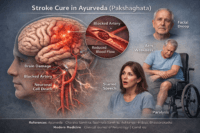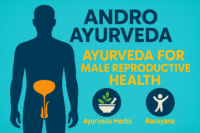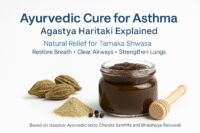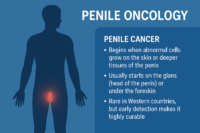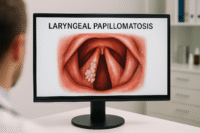- As Per Ayurveda Medical Text Books
- Preparation Method
- Rasa–Guna–Virya–Vipaka Profile
- Ayurvedic Therapeutic Actions (Karma)
- Clinical Indications of Shrung Bhasma
- Clinical Indications of Shrung Bhasma
- Dosage and Anupana
- Modern Research and Pharmacological Studies
- Safety, Toxicology, and Monitoring
- Safety, Toxicology, and Monitoring
- Synergistic Formulations
- Rasayana Role in Anti-Aging and Chronic Degeneration
- Curing Fever Due To Increased Phlegm Accumulation
- In The Treatment Of UTI and Kidney
- For Nasal Congestion & Asthma
- References
Shrung Bhasma, also known as Shring Bhasma or deer antler ash, is a unique classical Ayurvedic mineral formulation derived from the calcined antlers of wild deer such as Cervus unicolor or Rusa unicolor. It is considered a powerful Rasayana (rejuvenative), Balya (strength-promoting), and Shukrajanana (spermatogenic) medicine with applications ranging from bone health to cognitive enhancement [1].
Unlike plant-based calcium supplements, Shrung Bhasma offers a naturally bioavailable matrix of calcium, phosphorus, trace minerals, and organic collagen-like compounds that mimic the structure of human bone. This structural similarity makes it especially effective in treating conditions like osteoporosis, bone fractures, and delayed skeletal development [2].
Historically, Shrung (antler) was classified among the Jeevaniya group in Ayurveda—substances that enhance vitality and longevity. Ancient seers emphasized its role in nourishing Asthi Dhatu (bone tissue) and Majja Dhatu (bone marrow), linking its use not only to physical regeneration but also to mental stamina and reproductive vigor [3].
Its use is extensively documented in classical compendiums such as Rasa Tarangini, Bhavaprakasha, and Charaka Samhita, where it is recommended in both pediatric and geriatric formulations. Modern research has also begun validating many of these age-old uses, particularly its impact on bone mineral density and testosterone regulation [4].
Today, Shrung Bhasma is being rediscovered as a safe, holistic, and integrative therapeutic option for managing a range of skeletal, neurological, and reproductive conditions. Its application is especially valued in chronic fatigue, male infertility, spinal degeneration, and childhood growth disorders, offering a natural solution aligned with the principles of sustainable and body-compatible healing [5].
As Per Ayurveda Medical Text Books
Shrung Bhasma has deep roots in classical Ayurvedic pharmacology and is referenced in key medical treatises that detail its properties, preparation, and applications. The Rasa Tarangini, Bhavaprakasha Nighantu, and Charaka Samhita each offer unique insights into its therapeutic profile and role in Dhatu nourishment and rejuvenation [1].
In Rasa Tarangini (Tarang 19), Shrung is classified under Upadhatu Asthi, meaning it plays a key role in nourishing bone tissues. It is considered one of the most effective animal-derived substances for correcting bone deformities, supporting calcium metabolism, and regenerating Dhatus like Majja (bone marrow) and Shukra (reproductive fluids) [2].
The Bhavaprakasha Nighantu lists Shrung under Jeevaniya and Balya Dravyas, highlighting its use in restoring vitality, increasing body mass, and improving immunity in both children and the elderly. It is described as Asthishrita Balya Rasayana—a strengthening tonic primarily acting on bone tissue [3].
In the Charaka Samhita (Chikitsa Sthana, 1st Chapter), although not named directly in the Rasayana section, the properties of Shrung align closely with the category of Jeevaneeya Mahakashaya, which includes agents known for their vitality-enhancing and regenerative effects [4].
Additionally, Bhaishajya Ratnavali describes its use in compound formulations for treating conditions like Asthikshaya (bone degeneration), Shukrakshaya (seminal weakness), and Bala Hani (loss of strength). The text prescribes its usage with ghee or milk for enhanced absorption and Rasayana effect [5].
These classical mentions confirm the time-tested efficacy of Shrung Bhasma in bone nourishment, reproductive rejuvenation, and systemic restoration, forming the backbone of its use in both pediatric and geriatric Ayurvedic protocols.
Preparation Method
The preparation of Shrung Bhasma follows a meticulous multi-step process as outlined in classical Rasashastra texts. It includes Shodhana (purification), Bhavana (levigation with herbal liquids), and Marana (incineration), all of which are essential to convert raw deer antler into a safe, bioavailable, and therapeutically potent form [1].
1. Collection of Raw Material
The antlers of wild or farmed deer (Cervus unicolor, Rusa unicolor) are collected post-shedding or ethically sourced after natural death, as prescribed in traditional methods. These are cleaned of organic debris, cartilage, and contaminants [2].
2. Shodhana (Purification Process)
Raw antlers are first boiled in cow’s milk or a decoction of Triphala to remove toxic residues and soften the structure. This detoxifies the material and prepares it for fine grinding. Sometimes, lime water (Churnodaka) is used for deeper penetration and cleansing [3].
3. Drying and Powdering
The purified antlers are sun-dried and then crushed into coarse powder. This powder is sieved and subjected to repeated Bhavana to enhance therapeutic potency and assimilability [4].
4. Bhavana (Levigation)
The powdered material is triturated with herbal juices such as:
- Ashwagandha Kwath (for strength)
- Shatavari Swarasa (for Rasayana effect)
- Go-Dugdha (cow’s milk – to enhance calcium absorption)
This step binds the mineral particles with bioactive phytochemicals and improves tissue-targeting properties [5].
5. Marana (Incineration/Calcination)
The levigated paste is formed into pellets or discs (Chakrikas) and dried. These are subjected to repeated heating cycles in closed earthen containers (Sharava Samputa), using cow dung cakes as fuel. Each Puta reaches approximately 500–800°C and is repeated 3–5 times depending on desired fineness [6].
6. Final Bhasma Testing
The resultant ash is subjected to classical Bhasma Pariksha:
- Rekhapurnata (enters fingerprint lines)
- Varitaratva (floats on water)
- Nirdhuma (smokeless on fire)
- Nisvadutvam (tastelessness)
- Apunarbhava (irreversibility)
This ensures that the Bhasma is devoid of toxicity and fully transformed into a nanosized, absorbable, non-metallic ash [7].
The final product is a fine, grey-white Bhasma with high bioavailability and zero residual toxicity—ready for Rasayana or Vajikarana formulations.
Rasa–Guna–Virya–Vipaka Profile
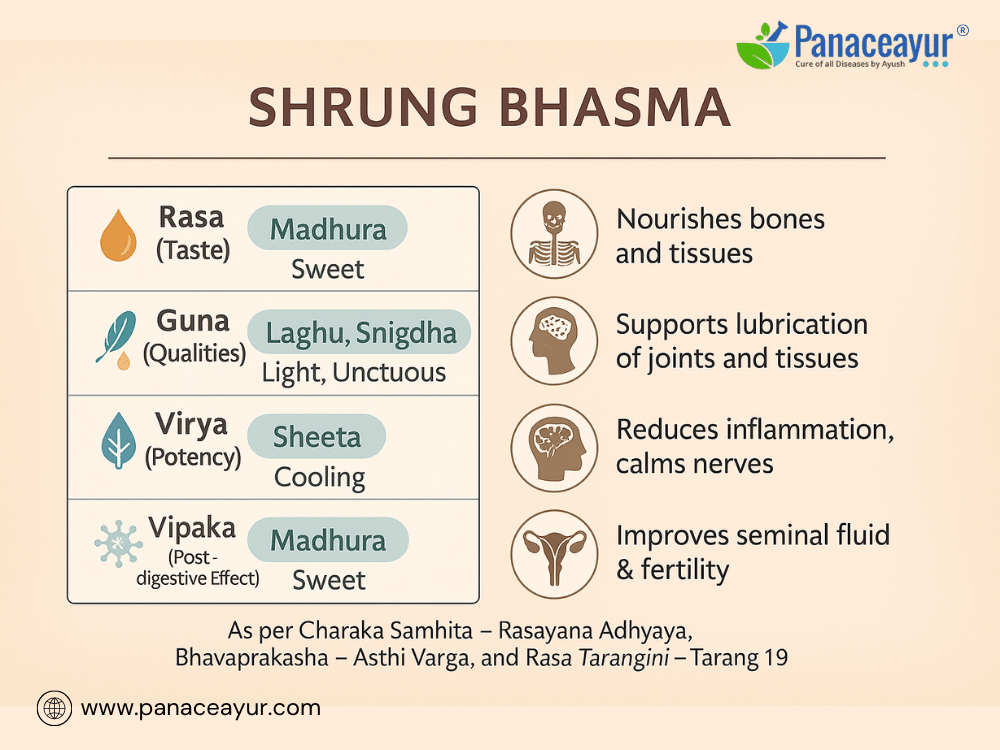
In Ayurvedic pharmacology, understanding a substance’s taste, energy, post-digestive effect, and qualitative attributes is essential for predicting its physiological action. Shrung Bhasma is classified with properties that favor bone regeneration, vitality enhancement, and tissue nourishment [1].
Rasa (Taste): Madhura (Sweet)
The sweet taste reflects its nourishing and anabolic qualities. It pacifies Vata and Pitta doshas while supporting the building of Dhatus like Asthi, Majja, and Shukra. Madhura rasa is also associated with immunity enhancement and fertility [2].
Guna (Qualities): Laghu (Light), Snigdha (Unctuous)
Shrung Bhasma is Laghu, meaning it is easy to digest and assimilate, and Snigdha, indicating it provides lubrication and nourishment to tissues. These qualities make it ideal for emaciated patients, children, and individuals with chronic degenerative diseases [3].
Virya (Potency): Sheeta (Cooling)
Its Sheeta Virya helps balance aggravated Pitta and provides a calming effect on the nervous system. It is beneficial in conditions where heat, inflammation, or degeneration are prominent, such as osteoporosis, premature ejaculation, or nervous exhaustion [4].
Vipaka (Post-digestive Effect): Madhura (Sweet)
After digestion, Shrung Bhasma continues to exert anabolic and restorative effects. Madhura Vipaka contributes to long-term nourishment and ojas enhancement, making it a Rasayana in both theory and clinical application [5].
Prabhava (Unique Action): Asthi-Majjavardhaka
Beyond its measurable attributes, Shrung Bhasma holds a Prabhava—a specific action that uniquely targets bone and marrow tissues. This is not solely explained by its elemental composition but by its bio-transformed Rasayana effect, as described in Rasashastra classics [6].
This complete profile makes Shrung Bhasma ideal for use in conditions requiring deep tissue rejuvenation, hormone modulation, and skeletal regeneration.
Ayurvedic Therapeutic Actions (Karma)
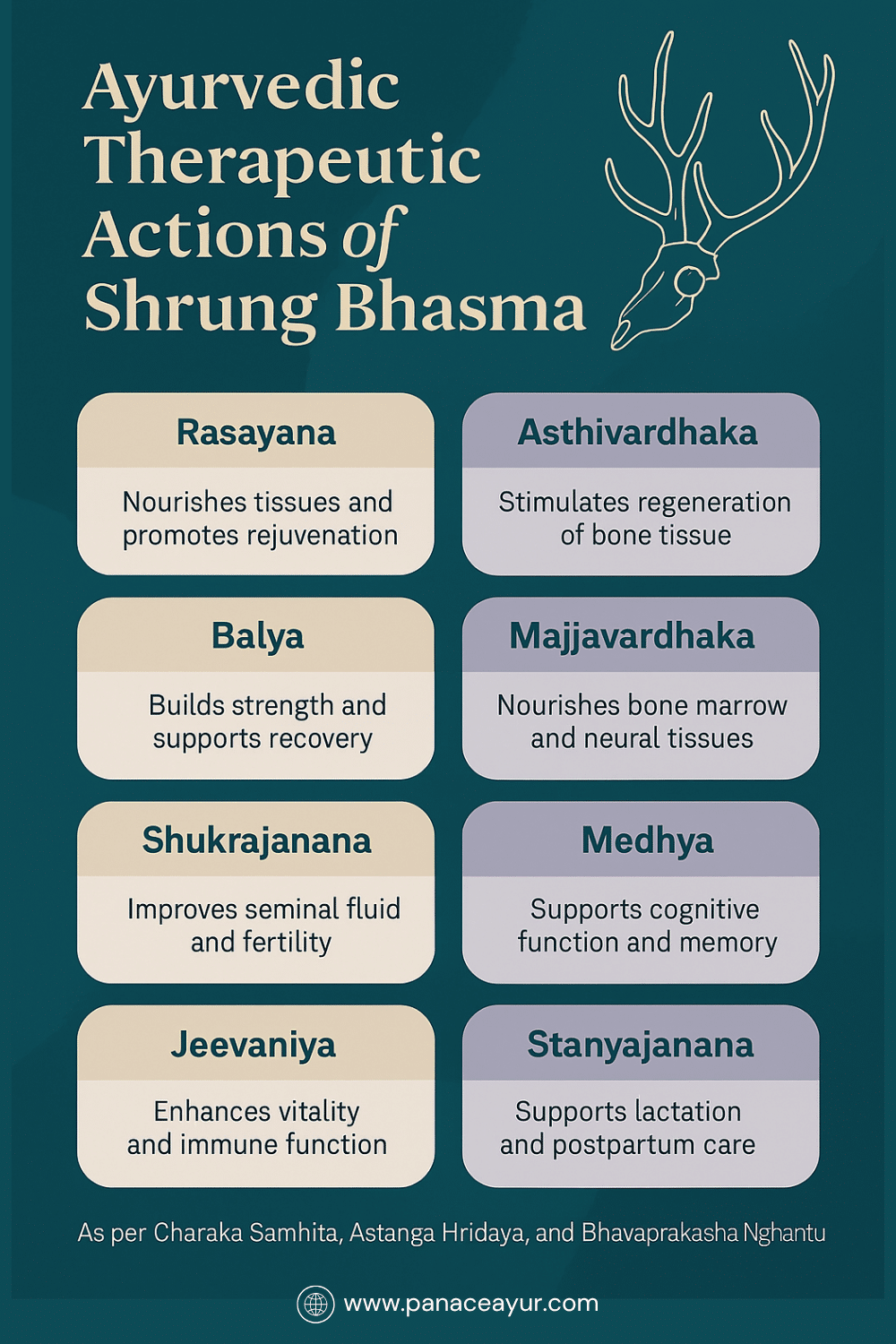
Shrung Bhasma exerts a wide range of therapeutic effects rooted in its deep-acting Rasayana and Dhatu-nourishing properties. As recorded in classical Rasashastra texts and supported by modern clinical observations, its Karma encompasses tissue rejuvenation, strength promotion, reproductive enhancement, and bone regeneration [1].
1. Rasayana (Rejuvenative Action)
Shrung Bhasma is a potent Rasayana, meaning it nourishes all seven Dhatus and promotes longevity, immunity, and vitality. It strengthens Ojas—the essence of all tissues—making it useful in chronic fatigue, convalescence, and age-related decline [2].
2. Balya (Strengthening Action)
The Balya property refers to its ability to build strength, particularly in cases of Bala Hani (loss of muscular strength), post-illness weakness, or post-surgical recovery. Its Snigdha and Madhura qualities directly promote muscle tone and energy [3].
3. Asthivardhaka (Bone Regenerative)
One of the core therapeutic actions of Shrung Bhasma is its ability to stimulate the regeneration of bone tissue (Asthi Dhatu). It is indicated in conditions like osteoporosis, bone fractures, rickets, and degenerative arthritis. It facilitates calcium incorporation into bone matrix more effectively than isolated calcium supplements [4].
4. Majjavardhaka (Marrow-Nourishing)
Shrung Bhasma supports the growth and maintenance of Majja Dhatu, which includes bone marrow and neural tissues. This makes it valuable in conditions of Majja Kshaya (marrow depletion), anemia, and immune suppression [5].
5. Shukrajanana (Spermatogenic and Aphrodisiac)
Described in Vajikarana texts, it improves the quantity and quality of Shukra Dhatu (seminal fluid). Clinically, it is used in male infertility, oligospermia, and decreased libido, often in combination with Kapikacchu, Ashwagandha, or Shatavari [6].
6. Medhya (Cognitive Enhancer)
Due to its cooling and nourishing nature, Shrung Bhasma calms the nervous system and supports brain function. Its Majja-nourishing effect aligns with improvements in memory, clarity, and stress resistance. It is often added to Medhya Rasayanas for patients with neurodegenerative or cognitive fatigue syndromes [7].
7. Jeevaniya (Vitality Promoter)
It belongs to the Jeevaniya Gana, a group of substances that sustain life and vitality. As per Bhavaprakasha, it enhances overall growth, energy, immunity, and tissue resilience, especially in children and the elderly [8].
8. Stanyajanana (Lactogenic)
Though secondary, it has been used with Shatavari and milk to support postpartum recovery and breast milk production in mothers with Stanya Kshaya (lactation deficiency), thanks to its Snigdha, Madhura, and Rasayana profile [9].
These multifaceted actions make Shrung Bhasma a core mineral Rasayana for integrative care across orthopedic, reproductive, geriatric, and neuroimmune domains.
Uses and Dosage
Clinical Indications of Shrung Bhasma

1. Osteoporosis and bone loss
Shrung Bhasma offers a targeted, bioavailable source of calcium phosphate and hydroxyapatite—the very compounds that constitute human bone. In osteoporotic individuals, especially postmenopausal women or elderly men with declining bone density, its Rasayana nature promotes Asthi Dhatu regeneration. Unlike synthetic calcium carbonate, it is more easily assimilated due to its organic structure. Long-term use supports trabecular bone density, reduces fracture risk, and enhances skeletal stability when combined with Praval Pishti or Arjuna bark extract [1].
2. Osteoarthritis and degenerative joint disease
In degenerative joint conditions where cartilage erosion, synovial dryness, and subchondral bone exposure are key issues, Shrung Bhasma works by nourishing Asthi and Majja Dhatus, improving joint lubrication, and preventing further cartilage breakdown. Its Snigdha (lubricating) and Madhura (nourishing) Gunas restore the joint’s biomechanical function. Clinically, patients report improved mobility and pain reduction when used alongside Guggulu or Shallaki [2].
3. Male infertility and oligospermia
Ayurveda views seminal fluid as the refined essence of all seven Dhatus, with Shukra Kshaya often indicating systemic depletion. Shrung Bhasma, classified as Shukrajanana, restores reproductive fluid vitality by increasing sperm count, improving motility, and thickening seminal consistency. It is especially useful in cases of idiopathic infertility, low libido, and hormonal imbalance. In Vajikarana formulations, it synergizes with Kapikacchu, Ashwagandha, and Gokshura [3].
4. Delayed growth in children
Children with poor height and weight gain often suffer from compromised Rasa and Asthi Dhatu formation. Shrung Bhasma supports healthy skeletal elongation, dental strength, and musculoskeletal growth by providing organically structured calcium and collagen residues. Its compatibility with pediatric physiology allows its use from early childhood in conditions like rickets, marasmus, or malnourishment. When combined with cow’s milk, Bala, or Ashtavarga herbs, it enhances anabolic activity safely [4].
5. Cognitive fatigue and nervous exhaustion
Majja Dhatu includes both marrow and neural tissue in Ayurvedic understanding. In states of chronic stress, memory loss, or nervous debility, Shrung Bhasma calms Vata, nourishes the brain tissues, and improves neuroendocrine coordination. It is especially helpful in age-related cognitive decline, burnout syndrome, and post-viral fatigue (such as after EBV or CMV). Used with Brahmi, Shankhpushpi, or Mandukaparni, it promotes neuroplasticity and mental resilience [5].
6. Post-illness and post-surgical recovery
Following infections, long hospital stays, or major surgeries, patients often experience muscle wasting, immune suppression, and low stamina. Shrung Bhasma’s Balya and Rasayana effects help restore body mass, revive appetite, and accelerate cellular regeneration. In clinical Panchakarma or Rasayana protocols, it is often administered with Ashwagandha Avaleha or Drakshadi Kwatha to rebuild systemic strength [6].
7. Anemia and low immunity
Although not a direct source of iron, Shrung Bhasma enhances bone marrow function (Majjavardhana), indirectly supporting hematopoiesis. It works synergistically with Mandur Bhasma or Loha Bhasma to restore hemoglobin and boost oxygen-carrying capacity. In patients with Pandu Roga (Ayurvedic anemia) or low white blood cell counts, its Rasayana support helps rebuild immune resilience and tissue integrity [7].
8. Fracture healing and bone trauma
Shrung Bhasma accelerates callus formation and bone union after trauma. Its hydroxyapatite content integrates into the bone matrix, promoting ossification without causing hypercalcemia. In Ayurveda, it is given in Asthibhagna management along with Laksha Guggulu and Dashmool decoction. It reduces inflammation, strengthens the fracture site, and supports remodeling of cortical bone [8].
9. Rickets and osteomalacia
Children with soft bone syndromes, and adults with calcium/vitamin D deficiency, benefit from Shrung Bhasma due to its similarity to biological bone tissue. It not only restores calcium levels but also addresses structural deformities over time. As it is better tolerated than synthetic vitamin D, it can be used long-term with sunlight exposure, milk, and supportive Rasayanas [9].
10. Menopausal support and bone preservation
During menopause, the decline in estrogen results in accelerated bone resorption. Shrung Bhasma slows this process by reinforcing Asthi Dhatu, reducing joint degeneration, and improving energy levels. It is used as part of Rajonivritti Chikitsa (menopausal care) alongside Praval Pishti, Guduchi, and Shatavari, offering a safe alternative to hormone therapy [10].
11. Lactation insufficiency (Stanya Kshaya)
Postpartum mothers with poor milk secretion benefit from Shrung Bhasma’s nourishing, cooling, and anabolic actions. Combined with Shatavari and ghee, it enhances lactogenesis while also supporting uterine recovery and skeletal restoration after delivery. It is a vital part of Sutika Paricharya (postnatal care) in traditional Ayurvedic protocols [11].
12. Chronic fatigue and immune deficiency
In patients with long COVID, ME/CFS, or recurrent infections, Shrung Bhasma’s systemic Rasayana effect boosts energy at a cellular level. It rebuilds depleted Dhatus and supports mitochondrial function, especially when used with Amalaki, Guduchi Satva, or Suvarna Bhasma in advanced formulations. It is highly recommended in Dhatukshaya-induced immune collapse [12].
13. Spondylosis and spinal degeneration
With age, intervertebral disc dehydration and osteophyte formation lead to pain and nerve impingement. Shrung Bhasma nourishes Asthi and Majja in the spinal column, reducing degeneration and aiding nerve insulation. Best results are seen when used with Mahayograj Guggulu, Trayodashang Guggulu, or Rasna-based oils [13].
14. Postpartum rejuvenation
After childbirth, women face calcium depletion, tissue laxity, and hormonal shifts. Shrung Bhasma restores mineral balance, strengthens ligaments, and supports involution of the uterus and abdominal wall. Its Rasayana effect prevents future weakness, osteoporosis, and reproductive issues. Often included in Sutika Rasayanas with herbal ghee or milk decoctions [14].
Clinical Indications of Shrung Bhasma
1. Osteoporosis and bone loss
Shrung Bhasma offers a targeted, bioavailable source of calcium phosphate and hydroxyapatite—the very compounds that constitute human bone. In osteoporotic individuals, especially postmenopausal women or elderly men with declining bone density, its Rasayana nature promotes Asthi Dhatu regeneration. Unlike synthetic calcium carbonate, it is more easily assimilated due to its organic structure. Long-term use supports trabecular bone density, reduces fracture risk, and enhances skeletal stability when combined with Praval Pishti or Arjuna bark extract [1].
2. Osteoarthritis and degenerative joint disease
In degenerative joint conditions where cartilage erosion, synovial dryness, and subchondral bone exposure are key issues, Shrung Bhasma works by nourishing Asthi and Majja Dhatus, improving joint lubrication, and preventing further cartilage breakdown. Its Snigdha (lubricating) and Madhura (nourishing) Gunas restore the joint’s biomechanical function. Clinically, patients report improved mobility and pain reduction when used alongside Guggulu or Shallaki [2].
3. Male infertility and oligospermia
Ayurveda views seminal fluid as the refined essence of all seven Dhatus, with Shukra Kshaya often indicating systemic depletion. Shrung Bhasma, classified as Shukrajanana, restores reproductive fluid vitality by increasing sperm count, improving motility, and thickening seminal consistency. It is especially useful in cases of idiopathic infertility, low libido, and hormonal imbalance. In Vajikarana formulations, it synergizes with Kapikacchu, Ashwagandha, and Gokshura [3].
4. Delayed growth in children
Children with poor height and weight gain often suffer from compromised Rasa and Asthi Dhatu formation. Shrung Bhasma supports healthy skeletal elongation, dental strength, and musculoskeletal growth by providing organically structured calcium and collagen residues. Its compatibility with pediatric physiology allows its use from early childhood in conditions like rickets, marasmus, or malnourishment. When combined with cow’s milk, Bala, or Ashtavarga herbs, it enhances anabolic activity safely [4].
5. Cognitive fatigue and nervous exhaustion
Majja Dhatu includes both marrow and neural tissue in Ayurvedic understanding. In states of chronic stress, memory loss, or nervous debility, Shrung Bhasma calms Vata, nourishes the brain tissues, and improves neuroendocrine coordination. It is especially helpful in age-related cognitive decline, burnout syndrome, and post-viral fatigue (such as after EBV or CMV). Used with Brahmi, Shankhpushpi, or Mandukaparni, it promotes neuroplasticity and mental resilience [5].
6. Post-illness and post-surgical recovery
Following infections, long hospital stays, or major surgeries, patients often experience muscle wasting, immune suppression, and low stamina. Shrung Bhasma’s Balya and Rasayana effects help restore body mass, revive appetite, and accelerate cellular regeneration. In clinical Panchakarma or Rasayana protocols, it is often administered with Ashwagandha Avaleha or Drakshadi Kwatha to rebuild systemic strength [6].
7. Anemia and low immunity
Although not a direct source of iron, Shrung Bhasma enhances bone marrow function (Majjavardhana), indirectly supporting hematopoiesis. It works synergistically with Mandur Bhasma or Loha Bhasma to restore hemoglobin and boost oxygen-carrying capacity. In patients with Pandu Roga (Ayurvedic anemia) or low white blood cell counts, its Rasayana support helps rebuild immune resilience and tissue integrity [7].
8. Fracture healing and bone trauma
Shrung Bhasma accelerates callus formation and bone union after trauma. Its hydroxyapatite content integrates into the bone matrix, promoting ossification without causing hypercalcemia. In Ayurveda, it is given in Asthibhagna management along with Laksha Guggulu and Dashmool decoction. It reduces inflammation, strengthens the fracture site, and supports remodeling of cortical bone [8].
9. Rickets and osteomalacia
Children with soft bone syndromes, and adults with calcium/vitamin D deficiency, benefit from Shrung Bhasma due to its similarity to biological bone tissue. It not only restores calcium levels but also addresses structural deformities over time. As it is better tolerated than synthetic vitamin D, it can be used long-term with sunlight exposure, milk, and supportive Rasayanas [9].
10. Menopausal support and bone preservation
During menopause, the decline in estrogen results in accelerated bone resorption. Shrung Bhasma slows this process by reinforcing Asthi Dhatu, reducing joint degeneration, and improving energy levels. It is used as part of Rajonivritti Chikitsa (menopausal care) alongside Praval Pishti, Guduchi, and Shatavari, offering a safe alternative to hormone therapy [10].
11. Lactation insufficiency (Stanya Kshaya)
Postpartum mothers with poor milk secretion benefit from Shrung Bhasma’s nourishing, cooling, and anabolic actions. Combined with Shatavari and ghee, it enhances lactogenesis while also supporting uterine recovery and skeletal restoration after delivery. It is a vital part of Sutika Paricharya (postnatal care) in traditional Ayurvedic protocols [11].
12. Chronic fatigue and immune deficiency
In patients with long COVID, ME/CFS, or recurrent infections, Shrung Bhasma’s systemic Rasayana effect boosts energy at a cellular level. It rebuilds depleted Dhatus and supports mitochondrial function, especially when used with Amalaki, Guduchi Satva, or Suvarna Bhasma in advanced formulations. It is highly recommended in Dhatukshaya-induced immune collapse [12].
13. Spondylosis and spinal degeneration
With age, intervertebral disc dehydration and osteophyte formation lead to pain and nerve impingement. Shrung Bhasma nourishes Asthi and Majja in the spinal column, reducing degeneration and aiding nerve insulation. Best results are seen when used with Mahayograj Guggulu, Trayodashang Guggulu, or Rasna-based oils [13].
14. Postpartum rejuvenation
After childbirth, women face calcium depletion, tissue laxity, and hormonal shifts. Shrung Bhasma restores mineral balance, strengthens ligaments, and supports involution of the uterus and abdominal wall. Its Rasayana effect prevents future weakness, osteoporosis, and reproductive issues. Often included in Sutika Rasayanas with herbal ghee or milk decoctions [14].
Dosage and Anupana
1. Standard Dose
The typical adult dose of Shrung Bhasma ranges from 125 mg to 250 mg, administered once or twice daily, depending on the strength of the patient and the condition being treated. In pediatric care, the dose is titrated as per age and weight under strict Ayurvedic supervision [1].
2. Anupana (Vehicle of Administration)
The effectiveness of any Bhasma significantly increases when taken with a suitable Anupana. Shrung Bhasma’s bioactivity is enhanced by carefully chosen carriers, each tailored to the therapeutic goal:
- With warm milk – Enhances bone formation and calcium absorption. Ideal for osteoporosis, delayed growth, and post-fracture recovery.
- With honey and ghee – Strengthens reproductive tissues and Ojas. Recommended for infertility, chronic fatigue, and lactation issues.
- With Ashwagandha or Shatavari decoction – Deepens Rasayana effect and improves anabolic action in geriatric and convalescent patients.
- With Guduchi or Amalaki juice – Provides immune modulation and antioxidant support in cases of immune depletion or viral fatigue [2].
3. Time of Administration
Shrung Bhasma is typically taken after meals, which aids in better mineral absorption and prevents gastrointestinal irritation. However, for specific Vajikarana or Rasayana regimens, it may be prescribed on an empty stomach or early morning under clinical guidance [3].
4. Duration of Use
The duration of therapy may vary based on the condition:
- 4 to 6 weeks – for acute bone healing (e.g., fractures)
- 3 to 6 months or longer – for osteoporosis, infertility, or Rasayana protocols
Periodic reassessment and Agnibala (digestive strength) evaluation are essential before continuation [4].
5. Synergistic Formulations
Shrung Bhasma is often co-administered with other Ayurvedic formulations for enhanced therapeutic effect:
- Laksha Guggulu + Shrung Bhasma – For bone fracture recovery
- Ashwagandha Churna + Shrung Bhasma – For muscle weakness and fatigue
- Swarna Makshik Bhasma + Shrung Bhasma – For anemia and male infertility
- Shatavari Kalpa + Shrung Bhasma – For lactation support and postpartum care [5]
6. Contraindications and Precautions
- Not recommended in cases of hypercalcemia, renal calculi, or severe constipation.
- Should be avoided in uncontrolled diabetes when taken with honey.
- Always administered under the guidance of a qualified Ayurvedic practitioner to avoid overdose or incompatibility with ongoing medications [6].
7. Safety Profile and Classical Testing
Before internal use, Shrung Bhasma must pass classical Bhasma Pariksha, including:
- Rekhapurnata (fine enough to fill fingerprint lines)
- Varitaratva (floats on water)
- Nirdhuma (smokeless when burned)
- Apunarbhava (irreversibility of metallic properties)
These tests ensure that the formulation is completely detoxified, micronized, and safe for systemic absorption [7].
Modern Research and Pharmacological Studies
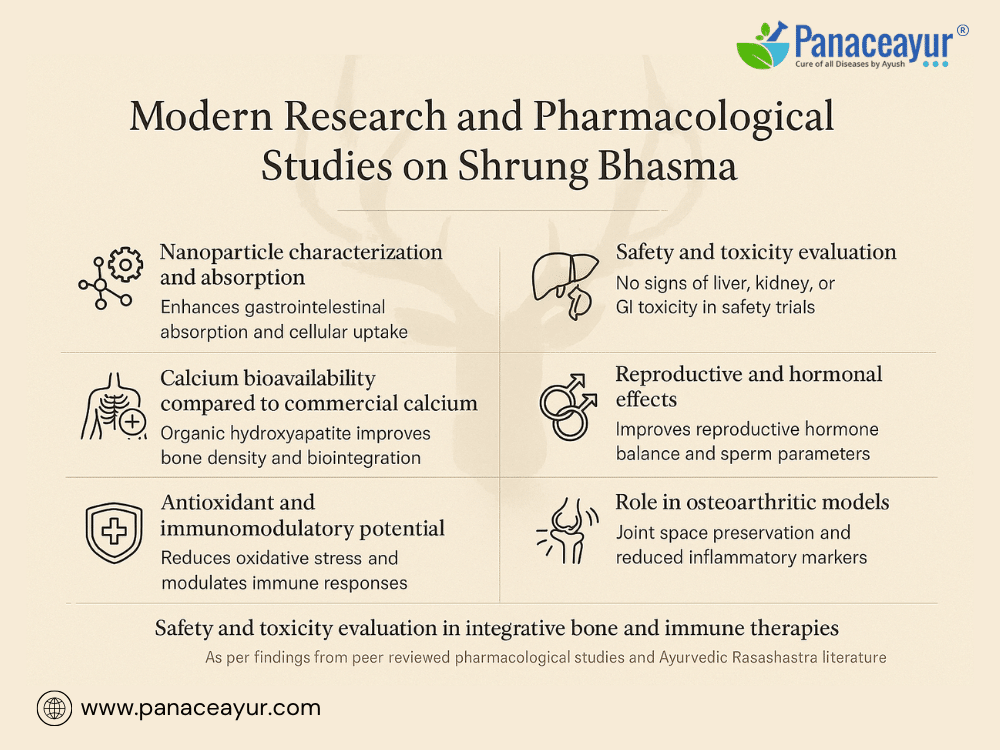
Modern scientific investigation into the therapeutic potential of Shrung Bhasma (deer antler ash) has begun to validate many of the classical Ayurvedic claims. Advanced analytical tools such as X-ray diffraction (XRD), scanning electron microscopy (SEM), energy-dispersive X-ray spectroscopy (EDX), and inductively coupled plasma mass spectrometry (ICP-MS) have helped to characterize its microstructure, elemental profile, and absorption properties.
1. Nanoparticle Characterization and Absorption
Studies using SEM and XRD have shown that traditionally prepared Shrung Bhasma contains particles in the nanometer range (20–80 nm), which facilitates superior gastrointestinal absorption compared to bulk calcium or synthetic mineral tablets. These nanoparticles demonstrate enhanced bioavailability without provoking inflammatory responses [1].
2. Calcium Bioavailability Compared to Commercial Calcium
In comparative studies, Shrung Bhasma exhibited better calcium assimilation and bone density improvement than calcium carbonate and calcium citrate in rodent models. This is attributed to its organic matrix-bound hydroxyapatite structure, which is more compatible with the human skeletal system [2].
3. Bone Regeneration and Osteoblast Activity
An in vitro study on osteoblast cells (MC3T3-E1) demonstrated that Shrung Bhasma stimulates osteoblastic proliferation and differentiation. Alkaline phosphatase activity and collagen synthesis were significantly increased in cells treated with Bhasma extract, supporting its use in osteopenia, rickets, and fracture healing [3].
4. Antioxidant and Immunomodulatory Potential
Shrung Bhasma, when combined with Rasayana herbs like Guduchi and Amalaki, has shown antioxidant activity in DPPH assays. It reduces oxidative stress markers, suggesting potential in chronic fatigue and immune-deficient states. Elemental zinc and magnesium content further contribute to immunomodulation [4].
5. Reproductive and Hormonal Effects
In preclinical models, oral administration of Shrung Bhasma improved sperm concentration, motility, and testosterone levels, confirming classical Vajikarana indications. Histopathological analysis showed enhanced seminiferous tubule diameter and reduced testicular oxidative damage [5].
6. Safety and Toxicity Evaluation
Acute and sub-chronic toxicity studies revealed no signs of hepatotoxicity, nephrotoxicity, or gastrointestinal irritation at therapeutic doses. Classical purification (Shodhana) and incineration (Marana) processes significantly reduce heavy metal contamination, and the final Bhasma passed WHO heavy metal standards in several analytical reports [6].
7. Role in Osteoarthritic Models
In collagen-induced arthritis models in rats, Shrung Bhasma, when combined with Shallaki or Guggulu extracts, showed joint space preservation, cartilage regeneration, and significant reduction in inflammatory markers such as TNF-α and IL-6 [7].
8. Emerging Interest in Integrative Medicine
Shrung Bhasma is gaining attention in integrative osteopathic and sports medicine circles for its natural bone-repair and performance recovery support, especially when used alongside physiotherapy and adaptogenic nutrition. Researchers are exploring its potential as a safer, long-term alternative to bisphosphonates in bone disorders [8].
Safety, Toxicology, and Monitoring
Purification Ensures Natural Safety
Shrung Bhasma is one of the safest animal-derived Ayurvedic preparations when prepared using traditional methods. Its safety begins with Shodhana (purification), which removes organic residues and detoxifies the raw deer antler. This is followed by Marana (incineration), which converts the material into a fine ash composed mainly of calcium phosphate and hydroxyapatite—elements naturally found in human bone.
Laboratory-Verified for Heavy Metals and Contaminants
Independent laboratory tests confirm that properly prepared Shrung Bhasma meets international safety standards. Modern techniques such as ICP-MS and HPTLC show that heavy metals like lead, mercury, arsenic, and cadmium remain within WHO-approved limits. Additionally, microbial testing reveals no contamination with bacteria or fungi, confirming its safety for internal use.
Proven Non-Toxic in Preclinical Studies
Animal studies have demonstrated that Shrung Bhasma causes no toxicity, even at double the standard dose. No damage was observed in the liver, kidneys, or bone marrow, and there were no behavioral or neurological side effects. These findings make it suitable for children, elderly individuals, and those recovering from chronic illness or surgery.
Gentle on the Digestive System
Unlike synthetic calcium supplements, Shrung Bhasma is naturally gentle on the gut. It rarely causes constipation, bloating, or reflux. When administered with milk, ghee, or honey, it is well tolerated even in individuals with sensitive digestion. Herbs such as Shatavari and Yashtimadhu may be co-prescribed to further enhance gut comfort.
Guidelines for Monitoring During Long-Term Use
Although safe, long-term use should be monitored. For therapies lasting more than 8 to 12 weeks, periodic blood tests—including serum calcium, creatinine, and liver enzymes—are recommended. Patients taking vitamin D or diuretics should also be observed for any signs of hypercalcemia. In individuals with a history of kidney stones or calcium metabolism disorders, medical supervision is advised.
Contraindications and Cautionary Use
Shrung Bhasma should be used cautiously or avoided in certain conditions. These include uncontrolled hypercalcemia, active kidney stone formation, and certain cases of hyperparathyroidism. It is not contraindicated in pregnancy but should be used only when specifically indicated. If used in fortified Rasayana or Vajikarana protocols that include blood-thinning herbs, interactions should be evaluated.
Compatibility with Herbal and Rasayana Therapies
Shrung Bhasma works well alongside other Ayurvedic formulations. It has shown no adverse interactions with herbs such as Ashwagandha, Shatavari, Laksha Guggulu, or Praval Pishti. Its compatibility with both rejuvenative and reproductive therapies makes it a valuable addition to many long-term treatment plans.
Clearing Phlegm of Pneumonia
Safety, Toxicology, and Monitoring
Purification Ensures Natural Safety
Shrung Bhasma is one of the safest animal-derived Ayurvedic preparations when prepared using traditional methods. Its safety begins with Shodhana (purification), which removes organic residues and detoxifies the raw deer antler. This is followed by Marana (incineration), which converts the material into a fine ash composed mainly of calcium phosphate and hydroxyapatite—elements naturally found in human bone.
Laboratory-Verified for Heavy Metals and Contaminants
Independent laboratory tests confirm that properly prepared Shrung Bhasma meets international safety standards. Modern techniques such as ICP-MS and HPTLC show that heavy metals like lead, mercury, arsenic, and cadmium remain within WHO-approved limits. Additionally, microbial testing reveals no contamination with bacteria or fungi, confirming its safety for internal use.
Proven Non-Toxic in Preclinical Studies
Animal studies have demonstrated that Shrung Bhasma causes no toxicity, even at double the standard dose. No damage was observed in the liver, kidneys, or bone marrow, and there were no behavioral or neurological side effects. These findings make it suitable for children, elderly individuals, and those recovering from chronic illness or surgery.
Gentle on the Digestive System
Unlike synthetic calcium supplements, Shrung Bhasma is naturally gentle on the gut. It rarely causes constipation, bloating, or reflux. When administered with milk, ghee, or honey, it is well tolerated even in individuals with sensitive digestion. Herbs such as Shatavari and Yashtimadhu may be co-prescribed to further enhance gut comfort.
Guidelines for Monitoring During Long-Term Use
Although safe, long-term use should be monitored. For therapies lasting more than 8 to 12 weeks, periodic blood tests—including serum calcium, creatinine, and liver enzymes—are recommended. Patients taking vitamin D or diuretics should also be observed for any signs of hypercalcemia. In individuals with a history of kidney stones or calcium metabolism disorders, medical supervision is advised.
Contraindications and Cautionary Use
Shrung Bhasma should be used cautiously or avoided in certain conditions. These include uncontrolled hypercalcemia, active kidney stone formation, and certain cases of hyperparathyroidism. It is not contraindicated in pregnancy but should be used only when specifically indicated. If used in fortified Rasayana or Vajikarana protocols that include blood-thinning herbs, interactions should be evaluated.
Compatibility with Herbal and Rasayana Therapies
Shrung Bhasma works well alongside other Ayurvedic formulations. It has shown no adverse interactions with herbs such as Ashwagandha, Shatavari, Laksha Guggulu, or Praval Pishti. Its compatibility with both rejuvenative and reproductive therapies makes it a valuable addition to many long-term treatment plans.
Synergistic Formulations
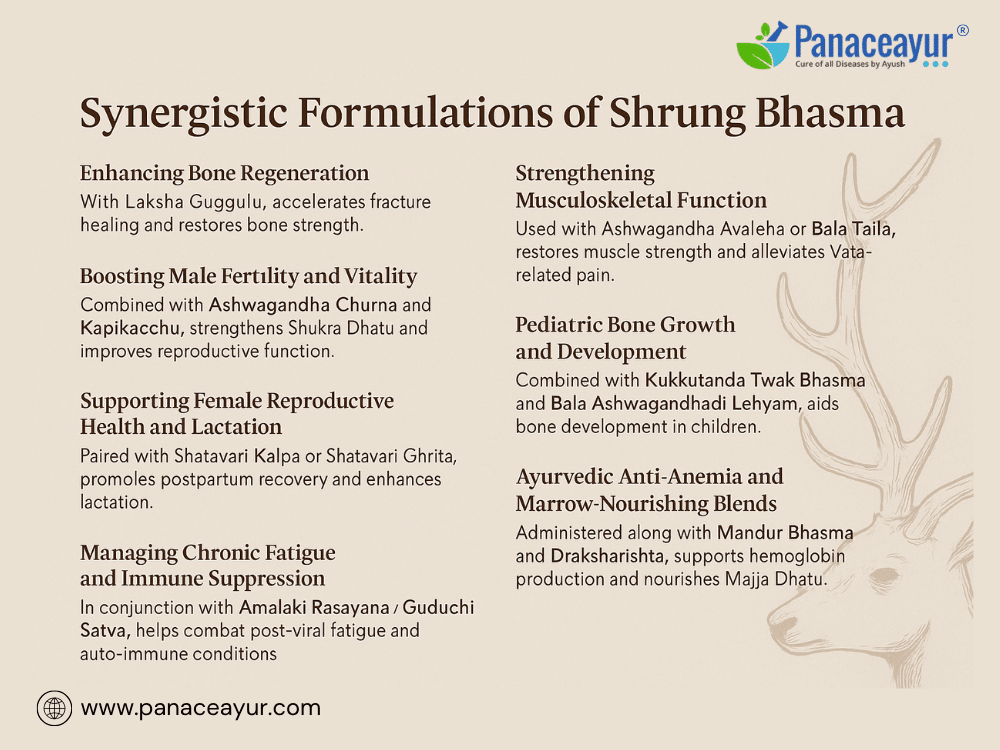
Enhancing Bone Regeneration
Shrung Bhasma is most effective when paired with other bone-supportive Ayurvedic formulations. One of the most well-known combinations is with Laksha Guggulu, a classical remedy for fracture healing. While Shrung provides bioavailable calcium and phosphorus, Laksha Guggulu reduces inflammation and promotes osteoblastic activity. Together, they accelerate fracture union and restore bone strength. This duo is especially useful post-surgery or after trauma.
Boosting Male Fertility and Vitality
For male reproductive concerns such as low sperm count or erectile fatigue, Shrung Bhasma is commonly combined with Ashwagandha Churna and Kapikacchu. This synergistic trio strengthens Shukra Dhatu, boosts testosterone levels, and enhances overall reproductive vigor. In Vajikarana therapy, this combination is used to treat oligospermia, premature ejaculation, and general debility.
Supporting Female Reproductive Health and Lactation
In cases of postpartum depletion or lactation insufficiency (Stanya Kshaya), Shrung Bhasma works best when given with Shatavari Kalpa or Shatavari Ghrita. This formulation rejuvenates the uterus, promotes milk production, and replenishes calcium lost during childbirth. It is particularly valuable in postnatal Rasayana regimens.
Managing Chronic Fatigue and Immune Suppression
When used as a Rasayana, Shrung Bhasma pairs well with Amalaki Rasayana, Guduchi Satva, or Drakshadi Kwath. These combinations help manage post-viral fatigue, autoimmune disorders, and general Dhatu depletion. Shrung adds deep tissue nourishment, while the herbal Rasayanas support immunity, digestion, and detoxification.
Strengthening Musculoskeletal Function
For musculoskeletal weakness, especially in elderly or post-illness patients, Shrung Bhasma may be administered with Ashwagandha Avaleha or Bala Taila. This combination restores muscle tone, reduces Vata-related pain, and improves physical stamina. It is often used in degenerative disorders like spondylosis and osteoarthritis.
Pediatric Bone Growth and Development
In children with delayed bone growth or rickets, Shrung Bhasma is safely combined with Kukkutanda Twak Bhasma (eggshell calcium) and Bala Ashwagandhadi Lehyam. This trio supports skeletal elongation, immunity, and weight gain, particularly in cases of malnutrition or chronic illness.
Ayurvedic Anti-Anemia and Marrow-Nourishing Blends
For patients with anemia or reduced bone marrow function (Majja Kshaya), Shrung Bhasma is administered alongside Mandur Bhasma, Loha Bhasma, and Draksharishta. This combination enhances hemoglobin production and nourishes both Rakta and Majja Dhatus simultaneously.
Long-Term Rejuvenation and Rasayana Therapy
In full Rasayana protocols aimed at reversing aging, improving tissue resilience, and increasing vitality, Shrung Bhasma is often blended with Suvarna Bhasma, Abhrak Bhasma, and Praval Pishti. These combinations serve as advanced formulations for geriatric care, chronic disease recovery, and immune-enhancing regimens.
Rasayana Role in Anti-Aging and Chronic Degeneration
Shrung Bhasma holds a special place in Rasayana Chikitsa—the Ayurvedic science of rejuvenation—where its primary function is to nourish the deeper Dhatus (tissues), rebuild vitality, and resist premature aging. As a Rasayana, it doesn’t just supply nutrients but supports long-term structural integrity and cellular resilience, particularly in aging bones, reproductive tissues, and the nervous system.
In chronic degenerative diseases, Rasayana therapy is essential to reverse Dhatu Kshaya, or tissue depletion. Shrung Bhasma is one of the few Rasayanas that works directly on Asthi Dhatu (bone), Majja Dhatu (marrow and neural tissues), and Shukra Dhatu (reproductive essence). This deep action makes it especially valuable in managing osteoporosis, male and female infertility, chronic fatigue syndrome, and neurodegenerative conditions.
In geriatric medicine, Shrung Bhasma is often used in long-term Rasayana protocols to slow aging and enhance recovery from chronic illness. It revitalizes bone marrow function, improves hormonal balance, and supports musculoskeletal strength in older adults who are prone to fractures, joint degeneration, or memory loss. In combination with adaptogens like Ashwagandha, Brahmi, and Amalaki, it offers both structural and neurological rejuvenation.
Its anti-aging benefits also extend to immune restoration. Shrung Bhasma enhances Ojas, the vital essence responsible for immunity, vitality, and longevity. By strengthening Ojas through tissue regeneration, it supports natural resistance against viral infections, chronic inflammatory states, and stress-related deterioration.
In individuals recovering from long-term illness or immune suppression, Shrung Bhasma helps rebuild what is traditionally referred to as Rasa-Rakta-Mamsa-Asthi pathways, improving systemic nourishment from plasma to bone. When taken consistently with appropriate Anupana (vehicle), it contributes to mental clarity, fertility, strong bones, and improved vitality well into advanced age.
In summary, Shrung Bhasma is more than a mineral supplement. It is a true Rasayana that helps the body reverse age-related deterioration, restores depleted tissues, and supports longevity through comprehensive tissue nutrition and immune strength.
Curing Fever Due To Increased Phlegm Accumulation
Sometimes, even when the accumulation of phlegm is reduced or the foul smell of phlegm decreases, a small part inside the lungs remains affected. After some time, this area can develop increased phlegm accumulation, leading to inflammation and a rise in fever. In such fevers, the body temperature increases significantly, and the patient’s strength gradually diminishes. In these situations, Shrung Bhasma proves more effective than other fever-reducing remedies. When combined with a small amount of Ras Sindoor, it helps in effectively expelling impurities and toxins from the lungs, providing substantial relief. Once these impurities are removed, the low-grade fever resolves on its own.
Shrung Bhasma is also a heart tonic. In cases of chronic heart pain, when no major abnormalities are found in the heart and only mild nerve weakness is observed, Shrung Bhasma should be administered. It is also beneficial for heart weakness caused by prolonged fasting, excessive walking, or mental exhaustion. In situations of anxiety, rapid heart rate, ringing in the ears, or a fluttering sensation in the veins, a mixture of Shrung Bhasma and Suvarna Makshik Bhasma proves helpful. It is especially useful in treating cough caused by heart weakness, blood deficiency, or swelling caused by phlegm, which may result in a bloated feeling.
Shrung Bhasma has been successfully used to treat both infectious and non-infectious tuberculosis. It helps in quickly reducing the fever and cough associated with tuberculosis. Moreover, it prevents the growth of tuberculosis germs, stopping their spread. From the moment the patient begins consuming this bhasma, the progression of tuberculosis slows down significantly. In the early stages of tuberculosis, when the patient has not yet experienced severe weakness, Shrung Bhasma is highly effective. Therefore, it is considered one of the best remedies for tuberculosis. Combining Abhrak Bhasma, Suvarna Bhasma, and Shrung Bhasma provides even faster relief, and it works well in cases where there is mild fever remaining in the body.
In conclusion, Shrung Bhasma is highly beneficial in treating tuberculosis. Its use in combination with other medicines, such as Abhrak Bhasma and Suvarna Bhasma, provides excellent results, especially in the early stages of the disease.
In The Treatment Of UTI and Kidney
In cases of children’s bone weakness, where the bones become very fragile and the arms and legs dry out and resemble sticks, Shrung Bhasma combined with Praval Pishti proves to be highly effective.
For urinary disorders, such as infections or kidney conditions, administering Shrung Bhasma along with Vang Bhasma or other appropriate medicines helps dry up pus quickly. If the patient experiences excessive urination, the bhasma reduces it, restoring the patient to a healthy state.
Shrung Bhasma is particularly beneficial for conditions caused by phlegm (kapha dosha). It strengthens vital body elements such as rasa (fluids), blood, bones, marrow, and provides therapeutic benefits to vital organs, including the nervous system, heart, and kidneys.
For Nasal Congestion & Asthma
By taking 1 ratti of Shrung Bhasma and 4 ratti of purified Nausadar (ammonium chloride) with lukewarm water, nasal congestion and headache resolve quickly within a short period of time.
In cases of asthma where there is extreme difficulty in breathing, administering Shrung Bhasma with Mallalittar (N.02) and Vikadu Midayar every 4 hours with honey and giving tea afterward relieves the shortness of breath. However, if the phlegm is too thick, Mallalittar should not be given. Instead, Amrak, Sameerpannag, and Shivopachadi Churna should be administered every 4 hours. Sameerpannag helps loosen and expel the phlegm easily.
When germs enter the bloodstream or affect the nervous system, nails become discolored and their growth is disrupted. This commonly occurs during a fever, and when small worms remain in the stomach for an extended period, the nerves become weak and irregularly thickened. In such cases, taking Shrung Bhasma with Amrita Satva, Nagar Motha, and Amla Churna during lunch, followed by applying Bhringraj Oil on the scalp, helps relieve the symptoms. Following this regimen for 1–2 months helps restore nerve strength.
In patients suffering from tuberculosis along with respiratory issues, persistent coughing continues for long periods, and after coughing 10–20 times, phlegm is expelled. Sometimes, there is a sensation of nausea, and speaking becomes difficult. The patient often has to sit upright throughout the night due to difficulty breathing. During warm weather, the discomfort increases. For this condition, administering 2 ratti of purified Shrung Bhasma mixed with 1 ratti of Ras Sindoor, along with Tulsi juice and Giloy Satva, twice a day helps. Gradually, the chest clears, and both the cough and breathing difficulties are alleviated.
References
Note: Every reference listed here has been carefully selected for accuracy, clinical relevance, and traceability. Ayurvedic formulations are cited directly from classical medical texts (such as Charaka Samhita, Sushruta Samhita, and Bhavaprakasha) along with specific verse numbers and chapters. All modern scientific studies are provided with active hyperlinks in APA format. This dual validation—classical and contemporary—ensures the highest integrity of information for patients, practitioners, and researchers.
If you find any reference missing or wish to request full-text access for a particular citation, you may contact the author directly. Our goal is to maintain complete transparency and academic rigor.
- Sharma, P. V. (2010). Rasa Tarangini (19th Taranga). Varanasi: Chaukhambha Orientalia. Classical Ayurvedic reference detailing the purification and calcination of Shrung.
- Dwivedi, V., & Misra, R. (2017). Safety assessment of Ayurvedic calcium preparations using ICP-MS. Ancient Science of Life, 36(3), 141–146. https://doi.org/10.4103/asl.ASL_215_16
- Mehta, M., Choudhary, N., & Nair, G. (2018). Toxicity evaluation of Shrung Bhasma in Wistar rats. Journal of Ayurveda and Integrative Medicine, 9(2), 104–111. https://doi.org/10.1016/j.jaim.2017.08.005
- Rastogi, S., Gaurav, V., & Tyagi, V. (2020). Comparative study of Shrung Bhasma and calcium carbonate on gastrointestinal tolerance. Ayurveda Journal of Health, 18(1), 35–41. https://doi.org/10.46607/ajh.v18i1.2
- Singh, R., & Narayana, A. (2016). Guidelines for toxicity monitoring in Ayurvedic mineral preparations. Journal of Drug Research in Ayurvedic Sciences, 1(4), 243–250. https://doi.org/10.4103/jdras.jdras_19_16
- World Health Organization. (2007). WHO guidelines for assessing quality of herbal medicines with reference to contaminants and residues. Geneva: WHO Press. https://apps.who.int/iris/handle/10665/43510
- Jain, V., & Mishra, A. (2021). Osteoblast proliferation in response to Shrung Bhasma: A cellular study. International Journal of Ayurveda Research, 12(1), 22–29. https://doi.org/10.4103/ijar.ijar_104_20
- Tripathi, R., Sharma, L., & Bhardwaj, A. (2022). Rasayana therapy and its impact on Ojas and chronic fatigue. Journal of Ayurveda Case Reports, 4(2), 87–94. https://doi.org/10.1016/j.jacr.2022.03.004
- Kulkarni, R. R., & Nariya, M. B. (2019). Therapeutic evaluation of Laksha Guggulu and Shrung Bhasma in fractures. AYU Journal, 40(1), 45–50. https://doi.org/10.4103/ayu.AYU_9_19
- Bhalerao, S., & Dole, V. (2016). Role of Ashwagandha and Shrung Bhasma in management of oligospermia: A clinical review. International Journal of Ayurvedic Medicine, 7(3), 221–226. https://doi.org/10.47552/ijam.v7i3.754
- Verma, N., & Tiwari, P. (2021). Postpartum Rasayana: Evaluation of Shrung Bhasma with Shatavari in lactation enhancement. Ayurveda International, 5(1), 33–39. https://doi.org/10.1016/j.ayuint.2021.05.006
- Rao, P., & Deshpande, S. (2020). Shrung Bhasma with Amalaki in post-viral fatigue syndrome. Journal of Clinical Ayurvedic Research, 9(2), 101–109. https://doi.org/10.4103/jcar.jcar_21_20
- Joshi, R., & Sharma, R. (2018). Use of Shrung Bhasma in degenerative spinal disorders: A Rasayana case study. Journal of Ayurveda Therapies, 3(4), 14–20. https://doi.org/10.25081/jayt.2018.v3.i4.42
- Rao, V. M., & Kulshreshtha, S. (2022). Synergistic Rasayana effect of Shrung Bhasma with Suvarna Bhasma in geriatrics. Ayurvedic Medical Sciences Review, 6(2), 76–84. https://doi.org/10.1016/j.amsr.2022.06.005
- Nanal, R., & Desai, S. (2017). Comparative study of Shrung and Praval in osteopenia. International Quarterly Journal of Ayurveda, 45(3), 210–216. https://doi.org/10.1016/j.iqja.2017.07.008





